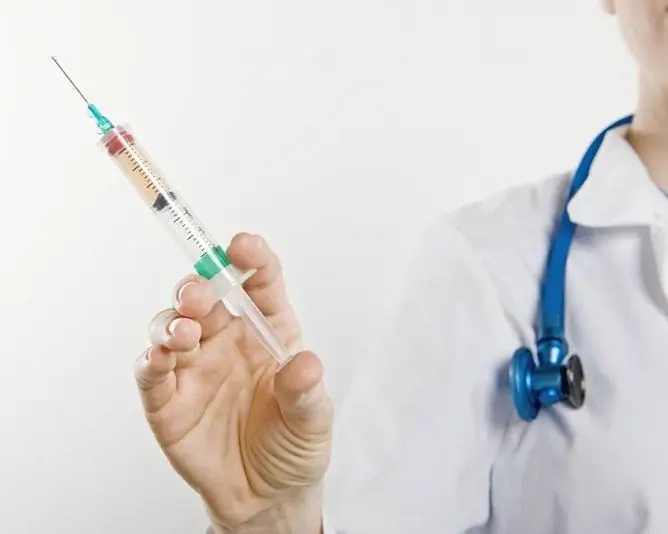- Author Rachel Wainwright [email protected].
- Public 2023-12-15 07:39.
- Last modified 2025-11-02 20:14.
Claforan
Claforan: instructions for use and reviews
- 1. Release form and composition
- 2. Pharmacological properties
- 3. Indications for use
- 4. Contraindications
- 5. Method of application and dosage
- 6. Side effects
- 7. Overdose
- 8. Special instructions
- 9. Application during pregnancy and lactation
- 10. Use in childhood
- 11. Drug interactions
- 12. Analogs
- 13. Terms and conditions of storage
- 14. Terms of dispensing from pharmacies
- 15. Reviews
- 16. Price in pharmacies
Latin name: Claforan
ATX code: J01DD01
Active ingredient: cefotaxime (cefotaxime)
Producer: Patheon UK (Great Britain), Zentiva Saglik Urunleri Sanayi ve Ticaret AS (Turkey), SOTEX Pharmaceutical Company (Russia)
Description and photo update: 2019-02-09
Prices in pharmacies: from 154 rubles.
Buy

Klaforan is a semi-synthetic antibiotic drug of the cephalosporin group for parenteral use.
Release form and composition
The drug is available in the form of a powder for the preparation of a solution for intravenous and intramuscular administration: yellowish-white or white (in glass colorless vials, 1 bottle in a cardboard box and instructions for use of Claforan).
1 bottle contains the active ingredient: cefotaxime - 1 g (in the form of sodium cefotaxime - 1.048 g).
Pharmacological properties
Pharmacodynamics
Cefotaxime - the active substance of Claforan, is a semi-synthetic antibiotic of the III generation cephalosporin group for parenteral use.
Possesses a wide spectrum of action. It has a bactericidal effect. Shows resistance to most β-lactamases.
Cefotaxime is active in relation to Klebsiella oxytoca, Klebsiella pneumoniae, Moraxella (Branhamella) catarrhalis, Bacillus subtilis, Aeromonas hydrophila, Bordetella pertussis, Borrelia burgdorferi, Citrobacter diversus, Clostridium colibacteri, Escherneppory (the sensitivity is determined by epidemiological data and the level of resistance in each specific country), Eubacterium spp., Erysipelothrix insidiosa, Neisseria gonorrhoeae (including strains producing and non-producing penicillinase), Neisseria meningitidis, Propionibacterium spp., Protegarus vulgaris spp. Proteus mirabilis, Salmonella spp., Streptococcus spp. (including Streptococcus pneumoniae), Haemophilus spp. (including strains producing and non-producing penicillinase, including ampicillin-resistant strains),methicillin-sensitive strains of Staphylococcus spp. (including strains producing and non-producing penicillinase), Morganella morganii, Serratia spp. (sensitivity is determined by epidemiological data and level of resistance in each specific country), Veillonella spp., Shigella spp., Yersinia spp. (the sensitivity is determined by epidemiological data and the level of resistance in each specific country).
Resistant to the effects of cefotaxime: gram-negative anaerobes, Enterococcus spp., Acinetobacter baumannii, Bacteroides fragilis, Listeria monocytogenes, Clostridium difficile, methicillin-resistant strains of Staphylococcus spp., Pseudomonas aerodynamic spp.
Pharmacokinetics
Plasma concentration of cefotaxime in the blood in adults 5 minutes after a single intravenous injection of 1 g of the substance is 100 μg / ml. After intramuscular administration of the same dose, the maximum plasma concentration in the blood is 20-30 μg / ml, the time to reach it is 0.5 hours.
T 1/2 (half-life) - 1 and 1-1.5 hours for intravenous and intramuscular administration, respectively.
Binds to plasma proteins (mainly albumin) at an average level of 25-40%.
Approximately 90% of the dose is excreted in the urine: unchanged - 50%, in the form of the metabolite deacetylcefotaxime - approximately 20%.
T 1/2 in elderly patients (over 80 years old) increases to 2.5 hours.
In the presence of impaired renal function in adults, the volume of distribution does not change, and the T 1/2 value does not go beyond 2.5 hours, even in the last stages of renal failure.
Plasma level and volume of distribution of cefotaxime in children, newborns and premature infants are similar to those in adults who receive the same dose of the drug at the rate of mg / kg. T 1/2 of cefotaxime is in the range of 0.75-1.5 hours.
Plasma levels of cefotaxime and volume of distribution in neonates and premature babies are similar to those in children. The average T 1/2 of the substance is 1.4-6.4 hours.
Indications for use
Claforan is prescribed for the treatment of diseases of an infectious and inflammatory nature caused by microorganisms sensitive to the action of cefotaxime:
- Infections of the respiratory and genitourinary system, soft tissues, skin, joints, bones, central nervous system, including meningitis (except listeriosis);
- Intra-abdominal (intra-abdominal) infections, including peritonitis;
- Septicemia;
- Endocarditis;
- Bacteremia
For the prevention of infectious complications, Claforan is used during obstetric-gynecological and urological operations and surgical interventions on the gastrointestinal tract.
Contraindications
The use of Claforan is contraindicated in the presence of hypersensitivity to cephalosporins.
When dissolving Claforan powder with lidocaine (intramuscular injection), there are the following contraindications to the use of the solution:
- Intravenous administration;
- Intracardiac blockade without an established pacemaker;
- Severe heart failure;
- Age up to 2.5 years (intramuscular injection);
- Hypersensitivity to lidocaine or other local anesthetics of the amide type.
Pregnant women should not be prescribed Claforan, since there is no reliable data confirming its effectiveness and safety. If it is necessary to carry out therapy during lactation, it is recommended to interrupt breastfeeding.
Claforan, instructions for use: method and dosage
Claforan solution is administered intramuscularly or intravenously (as a slow injection or infusion).
With normal renal function, adults are advised to adhere to the following dosing regimen:
- Uncomplicated gonorrhea: once intramuscularly 0.5-1 g;
- Uncomplicated infections of moderate severity: intramuscularly or intravenously, single dose - 1-2 g, daily dose - 2-6 g, interval between injections - 8-12 hours;
- Severe infections: intravenously, single dose - 2 g, daily dose - 6-8 g, interval between injections - 6-8 hours.
With insufficient sensitivity of infection strains to the action of the drug, the only means of confirming the effectiveness of Claforan is a test for determining the sensitivity to it.
Adults with functional impairments of the kidneys (with creatinine clearance (CC) of 10 ml per minute or less), a single dose should be reduced by 2 times, maintaining the duration of the interval between injections (the daily dose is reduced by 2 times).
If it is not possible to measure CC, it can be calculated based on serum creatinine levels using the Cockcroft formula for adults.
Men can use one of two formulas:
- Body weight (kg) x (140-age) / 72 x serum creatinine (mg / dl);
- Body weight (kg) x (140-age) / 0.814 x serum creatinine (μmol / L).
Women in order to calculate the CC should use the formula: 0.85 x indicator for men.
For patients on hemodialysis, Claforan is prescribed in a daily dose of 1-2 g (determined by the severity of the infection; the solution is administered after the end of the procedure).
Recommended dosage regimen of Klaforan for children:
- Prematurely born children (up to 1 week of life): intravenously, a daily dose of 0.05-0.1 g / kg, divided into 2 injections with a break of 12 hours;
- Prematurely born children (1-4 weeks of life): intravenously, a daily dose of 0.075-0.15 g / kg, divided into 3 injections with an interval of 8 hours;
- Children weighing up to 50 kg: intravenously or intramuscularly, the daily dose is 0.05-0.1 g / kg (administered with a break of 6-8 hours). Do not exceed a daily dose of 2 g. In severe infections, including meningitis, the daily dose may be doubled;
- Children weighing 50 kg or more: the drug is used in adult doses.
For children under 2.5 years of age, intramuscular administration of Claforan dissolved in 1% lidocaine is strictly contraindicated.
In order to prevent the occurrence of postoperative infections before the operation during the induction of anesthesia, Klaforan is administered intramuscularly or intravenously at a dose of 1 g. Repeated administration at the same dose is carried out 6-12 hours after the operation.
When clamps are applied to the umbilical vein during a cesarean section, the solution is administered intravenously at a dose of 1 g, after 6-12 hours the same dose of Claforan is re-administered (intramuscularly or intravenously).
The doctor sets the duration of therapy individually.
To prepare a solution for intramuscular injections of Claforan, you need to dissolve the powder with sterile water for injection: 4 ml for 1 g of powder and 10 ml for 2 g. 1% lidocaine solution can be used as a solvent (intravenous administration is strictly contraindicated).
To prepare a solution for intravenous administration, 1 g or 2 g of powder is dissolved in 40-100 ml of an infusion solution or sterile water for injection. The injection should be carried out slowly over 3-5 minutes (due to the possible development of life-threatening arrhythmias with the introduction of Claforan through a central venous catheter). For infusion, you can use such solutions (concentration of cefotaxime 1 g / 250 ml), such as: water for injection, 0.9% sodium chloride solution, Ringer's solution, 5% glucose (dextrose) solution, sodium lactate solution, and also ionosteril solutions, gemaccel, 12% rheomacrodex, 6% macrodex, tutofusin B.
When dissolving the powder, aseptic conditions should be ensured, especially if the Claforan solution is not injected immediately.
Side effects
- Cardiovascular system: in isolated cases - arrhythmias (when carrying out a bolus injection through a central venous catheter);
- Urinary system: deterioration of renal function (increase in creatinine levels), especially when used simultaneously with aminoglycosides; very rarely - interstitial nephritis;
- Digestive system: possible - vomiting, nausea, abdominal pain, increased activity of hepatic enzymes (gamma-glutamyltransferase, alanine aminotransferase, lactate dehydrogenase, aspartate aminotransferase, alkaline phosphatase) and / or bilirubin, diarrhea (may indicate that sometimes enterocolin develops, diarrhea) blood; a special form of enterocolitis is pseudomembranous colitis);
- Central nervous system: encephalopathy (with the introduction of high doses), especially against the background of renal failure;
- Hematopoietic system: neutropenia; rarely - eosinophilia, thrombocytopenia, agranulocytosis; in isolated cases - hemolytic anemia;
- Allergic reactions: urticaria, skin redness, angioedema, rash, bronchospasm; very rarely - Stevens-Johnson syndrome, erythema multiforme, anaphylactic shock, toxic epidermal necrolysis (Lyell's syndrome);
- Local reactions: inflammation at the injection site;
- Others: fever, weakness, superinfection.
With the treatment of borreliosis, the following disorders may develop: shortness of breath, skin rash, fever, itching, Jarisch-Herxheimer reaction (in the first days of therapy), increased liver enzymes, leukopenia, discomfort in the joints.
Overdose
The main symptoms: the risk of reversible encephalopathy.
Therapy: symptomatic treatment. There is no specific antidote.
special instructions
Before starting the use of Claforan, it is necessary to collect an allergic history, in particular with regard to indications of allergic diathesis, hypersensitivity reactions to beta-lactam antibiotic drugs. In 5-10% of cases, cross-allergy occurs between cephalosporins and penicillins. With extreme caution, Klaforan should be prescribed to patients with a history of allergic reactions to penicillin.
The presence of anamnestic data on immediate hypersensitivity reactions to cephalosporins is a strict contraindication to the use of Claforan. In case of any doubts, the presence of a doctor is necessary at the first administration of the solution, which is associated with the likelihood of anaphylactic reactions.
With the development of hypersensitivity reactions, Claforan is canceled.
In the first weeks of therapy, pseudomembranous colitis may develop, which is manifested by severe prolonged diarrhea. The diagnosis is confirmed by histological examination and / or colonoscopy. This complication is very serious, therefore, therapy should be discontinued immediately and adequate treatment should be prescribed (including oral administration of metronidazole or vancomycin).
With the simultaneous appointment of Klaforan with potentially nephrotoxic drugs (aminoglycoside antibiotics, diuretics), it is necessary to control renal function, which is associated with the danger of nephrotoxic action.
If it is necessary to limit sodium intake, it should be borne in mind that cefotaxime sodium salt contains 48.2 mg / g sodium.
When using Claforan, it is recommended to use glucose oxidase methods for determining blood glucose levels, which is associated with the development of false-positive results when using nonspecific reagents.
During the period of therapy, a false-positive Coombs test may appear.
It is necessary to control the rate of administration of Claforan.
With prolonged therapy (longer than 10 days), it is necessary to monitor the picture of peripheral blood. With the development of neutropenia, Claforan is canceled.
Application during pregnancy and lactation
Claforan is not prescribed during pregnancy / lactation.
Pediatric use
The use of Claforan intramuscularly when using lidocaine as a solvent in patients under 2.5 years of age is contraindicated.
Drug interactions
When Klaforan is co-administered with certain drugs, the following effects may occur:
- Probenecid: delayed excretion and increased plasma concentrations of cefotaxime;
- Drugs with nephrotoxic effect: potentiation of their nephrotoxic effect.
Claforan's solution should not be mixed in the same infusion solution or syringe with solutions of other antibiotic drugs (including aminoglycosides).
Analogs
Klaforan analogs are: Klafotaxime, Intrataxime, Liforan, Kefotex, Oritax, Klafobrin, Oritaxime, Spirozin, Talcef, Cetax, Tirotax, Cefabol, Tarcefoxim, Cefantral, Tax-o-Bid, Cefosin, Resibelacta, Cefotaximek, Cefotaxime Cefotaxime-Vial, Cefotaxime-Promed, Cefotaxime DS, Cefotaxime sodium, Cefotaxime Elfa, Cefotaxime-LEXVM, Cefotaxime sodium salt.
Terms and conditions of storage
Store in a dark place, out of reach of children, at temperatures up to 25 ° C.
Shelf life is 2 years.
Storage of prepared solutions:
- Solution for intramuscular injection, prepared using water for injection or 0.5% or 1% lidocaine hydrochloride solution: 8 hours (at room temperature up to 25 ° C) or 24 hours (when stored at 2-8 ° C protected from light place);
- Solution for infusion, prepared using infusion solutions: 8 hours (gemaccel solution, tutofusin or ionosteril) or 6 hours (10% dextrose (glucose) solution, rheomacrodex or macrodex);
- Solution for infusion or injection, prepared with water for injection: 12 hours (at room temperature up to 25 ° C) or 24 hours (when stored at 2-8 ° C in a dark place). The appearance of a pale yellow tint does not mean a decrease in the activity of the drug.
Terms of dispensing from pharmacies
Dispensed by prescription.
Reviews about Claforan
Reviews about Claforan are mostly positive. It is characterized as a highly effective drug with a broad spectrum of action and good tolerance. In rare cases, local adverse reactions are noted at the injection site of the Claforan. The cost in comparison with analogs is estimated as high.
Price for Claforan in pharmacies
The approximate price for Claforan (1 bottle of 1 g) is 93-159 rubles.
Claforan: prices in online pharmacies
|
Drug name Price Pharmacy |
|
Claforan 1 g powder for preparation of solution for intravenous and intramuscular administration 1 pc. 154 RUB Buy |

Maria Kulkes Medical journalist About the author
Education: First Moscow State Medical University named after I. M. Sechenov, specialty "General Medicine".
Information about the drug is generalized, provided for informational purposes only and does not replace the official instructions. Self-medication is hazardous to health!






